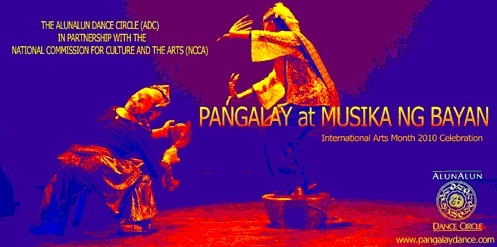Launched in partnership with the National Commission for Culture and the Arts (NCCA) on the occasion of International Arts Month in February 2010, about 4000 young people watched the five separate performances of “Pangalay at Musika ng Bayan” (Pangalay and Music of the People) in Manila and Angeles City.
Two Performances at the Emilio Aguinaldo College, Manila
12 February 2010
The pangalay performances at the Emilio Aguinaldo College (EAC) in Manila last 12 February 2010 was a triumph for both the AlunAlun Dance Circle, headed by Ms. Ligaya Fernando-Amilbangsa, and the student body of EAC. “Pangalay at Musika ng Bayan” coincided with the College Foundation Day presentations, making the celebration of International Arts Month more meaningful to the audience.
Earlier pangalay workshops conducted for the students of EAC by Nannette Matilac in January 2007 produced a group of pangalay admirers and practitioners who continued propagating and dancing pangalay within and outside the EAC campus. As a result of this undertaking, the Pangalay Artists Circle was formed in 2007. Then in 2009, the Yaman-Lahi Dance Artists, which became the official dance group of the Emilio Aguinaldo College, also took up pangalay. The establishment of youth dance groups utilizing pangalay is a remarkable development in the over-all popularization and preservation of pangalay. Hopefully, the young people’s laudable efforts will create ripples outside of their immediate community.
The informative segment called “What is Pangalay?” was performed by the EAC pangalay dancers, who moved with graceful ease and confidence. Several dances from the repertoire of the AlunAlun Dance Circle in Hanoi in 2009 delighted the audience: “Sa Ugoy ng Duyan”, a poignant portrayal of mother’s love to the music of National Artist Lucio San Pedro and lyrics by National Artist Levi Celerio; “Sa Kabukiran”, a playful choreography to the musical composition by Manuel Velez music transcribed by violinist Gilopez Kabayao accompanied by pianist Corazon Pineda; “Tsismis”, a witty spoof on the spread of rumors danced to the novelty song of Yoyoy Villame; and “Bonggahan” which is a Pinoy rock rendition by Sampaguita that admonishes everyone to join the merrymaking—if only to momentarily forget problems or mundane concerns. The final bow of “Pangalay at Musika ng Bayan” was a performance in itself, utilizing the pangalay obeisance or curtsy, to the live rendition of the Pangalay Artists Circle musicians.
Over-all, “Pangalay at Musika ng Bayan” in EAC was very inspiring because the ADC performed with young people who were touched by the beauty of pangalay when they underwent basic pangalay training three years ago. It was heartwarming and encouraging to know that the students continued to preserve the endangered dance form through continuous performances within and outside the campus. – Rama Marcaida
Three Performances at the Holy Angel University, Angeles City
23 February 2010
In honor of International Arts Month 2010, the AlunAlun Dance Circle, with the support of the NCCA, rendered three one-hour performances at the Holy Angel University theatre in Angeles City. This was arranged with the office of the university President, Dr. Arlyn Villanueva, through the Director of the Juan D. Nepomuceno Kapampangan Studies Center, Robby Tantingco. About 800 P.E. students and their teachers, plus university officials, attended each performance, for a total audience of approximately 2,500.
Nine AlunAlun members performed a repertoire consisting of traditional pangalay with ethnic musical accompaniment, and modern choreography in the pangalay dance style to the music of nationally acclaimed Filipino masters Gilopez Kabayao and Ernani Cuenco, and folk/pop singers Yoyoy Villame and Sampaguita.
An introduction to “What is Pangalay?” explained the provenance of the dance style and the meaning of the various body stances and hand and finger movements, emphasizing pangalay’s rich movement vocabulary and its closeness to other Asian classical dances. The main message conveyed was that pangalay is a precious part of our cultural heritage, and we should do everything we can to preserve and propagate it.
The audience response ranged from very positive to enthusiastic, with the students asking questions during the Open Forum. During the instructional segment of the program, some brave volunteers came on stage to learn the movements, to much cheering and amusement.
Our Artistic Director, Ligaya F. Amilbangsa, and some of the other AlunAlun members, were later interviewed for a video presentation project by two students. The students were curious as to what led the individual dancers to take up pangalay, and rued the fact that such a beautiful part of our culture is so little-known.
It is our hope that with these outreach performances we were able to inspire the younger generation to take more interest in our indigenous dance heritage—learn it, preserve it and perform it. – Mariel Francisco

Leave a Reply